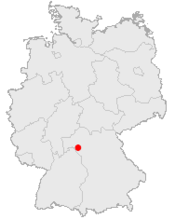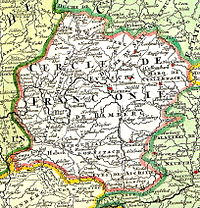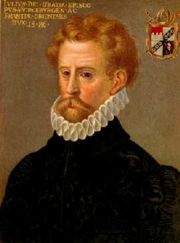- Bishopric of Würzburg
-
For the modern diocese, see Roman Catholic Diocese of Würzburg.
Bishopric of Würzburg
Bistum WürzburgState of the Holy Roman Empire ← 
1168–1803  →
→

Flag Coat of arms Würzburg, shown within modern Germany. Capital Würzburg Language(s) East Franconian German Religion Roman Catholic Government Theocracy Prince-Bishop - 743–55
(founding Bishop)
St Burchard I- 1165–70
(first Prince-Bishop)
Herold von Hochheim- 1795–1808
(Prince-Bishop to 1803)
Georg Karl von FechenbachHistorical era Middle Ages - Bishopric founded 743 - Raised to prince-bishopric 1168 - Prince-Bishops styled
Dukes in Franconia
1441- Ecclesiastical Prince
of Franconian Circle
1500- Secularised and
annexed by BavariaFebruary 25, 1803 1803 - Ceded to Ferdinand and
raised to Grand Duchy30 September 1806 The Bishopric of Würzburg (German: Würzburg) was a prince-bishopric in the Holy Roman Empire, located in Lower Franconia, around the city of Würzburg, Germany. Würzburg was a diocese from 743. In the 18th century, its bishop was often also Bishop of Bamberg. The last few prince-bishops resided at the Würzburg Residence, which is one of the grandest baroque palaces in Europe.
As a consequence of the 1801 Treaty of Lunéville, the Bishopric of Würzburg was secularized in 1803 and annexed by the Elector of Bavaria. In the same year Ferdinand III, former Grand Duke of Tuscany, was compensated with the Electorate of Salzburg. In the 1805 Peace of Pressburg, Ferdinand lost Salzburg to the Austrian Empire, but was compensated with the new Grand Duchy of Würzburg, Bavaria having relinquished the territory in return for the Tyrol. This new state lasted until 1814, when it was once again annexed by Bavaria.
The Roman Catholic Diocese of Würzburg was reestablished in 1821 without temporal power.
Contents
Duke in Franconia
In 1115, Henry V awarded the territory of Eastern Franconia (Ostfranken) to his nephew Conrad of Hohenstaufen, who used the title "Duke of Franconia." Franconia remained a Hohenstaufen power base until 1168, when the Bishop of Würzburg was formally ceded the ducal rights in Eastern Franconia. The name "Franconia" fell out of usage, but the bishop revived it in his own favour in 1442 and held it until the reforms of Napoleon Bonaparte abolished it. The Bishop of Würzburg was more properly the Duke in Franconia (Herzog in Franken) rather than the Duke of Franconia (Herzog von Franken) during this time although both titles were used.
Coat of arms
In 741 or 742 the first bishop of Würzburg was consecrated by Saint Boniface. The charge of the original coat of arms showed the “Rennfähnlein” banner, quarterly argent and gules, on a lance or, in bend, on a blue shield. In the 14th century another coat of arms was created. The coat of arms represents the holism of heaven and earth. The three white pikes represent the trinity of god and the four red pikes, directed to earth, stand for the four points of the compass, representing the whole spread of earth. The red colour represents the blood of Christ.
The Prince-Bishops used both within their personal coat of arms. The Rechen and the Rennfähnlein represented the diocese, while the other (usually two) fields showed the personal coat of arms of the bishop’s family. The coat of arms showed the Rechen in the first and third field, the Rennfähnlein in the second and fourth field.[1]
Bishops of Würzburg, 743–1808
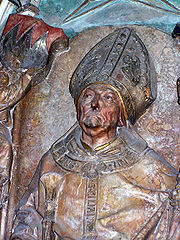 Prince-Bishop Rudolf von Scherenberg
Prince-Bishop Rudolf von Scherenberg
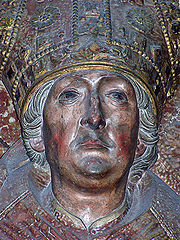 Prince-Bishop Lorenz von Bibra
Prince-Bishop Lorenz von Bibra
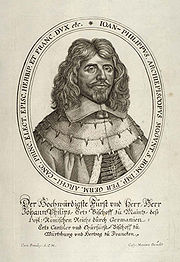 Prince-Bishop Johann Philipp von Schönborn
Prince-Bishop Johann Philipp von Schönborn
- St. Burchard I 743–755
- St. Megingold von Rothenburg 755–769
- Bernulf 769–800
- Luderich 800–803
- Egilwart 803–810
- Wolfgar 810–832
- Hunbert 833–842
- Godwald von Henneberg 842–855
- Arno von Endsee 855–892
- Rudolf I von Conradines892–908
- Theodo von Henneberg 908–931
- Burchard II 932–941
- Poppo I 941–961
- Poppo II 961–983
- Hugo von Rothenburg 983–990
- Bernward von Rothenburg 990–995
- Heinrich I von Rothenburg 995–1018
- Meinhard I von Rothenburg 1018–1034
- Bruno of Carinthia 1034–1045
- Adalbero von Lambach-Wels 1045–1085
- Meinhard II von Rothenburg 1085–1088
- Einhard von Rothenburg 1089–1105
- Rupert von Tundorf 1105–1106
- Erlung von Calw 1106–1121
- Gebhard von Henneberg 1122–1127
- Rudiger von Vaihingen 1122–1125
- Emicho von Leiningen 1125–1146
- Siegfried von Truhendingen 1146–1150
- Gebhard von Henneberg 1150–1159
- Heinrich II von Stuhlingen 1159–1165
- Herold von Hochheim 1165–1170
- Reginhard von Abenberg 1171–1186
- Gottfried I von Spitzenberg-Helfenstein 1186–1190
- Philipp of Swabia 1190–1191
- Heinrich III of Berg 1191–1197
- Gottfried II von Hohenlohe 1197
- Konrad von Querfurt 1197–1202
- Heinrich IV von Katzburg 1202–1207
- Otto von Lobdeburg 1207–1223
- Dietrich von Homburg 1223–1225
- Hermann I von Lobdeburg 1225–1254
- Iring von Reinstein-Homburg 1254–1266
- Heinrich V von Leiningen 1254–1255
- Poppo III von Trimberg 1267–1271
- Berthold I von Henneberg 1271–1274
- Berthold II von Sternberg 1274–1287
- Mangold von Neuenburg 1287–1303 (Bishop of Bamberg 1285)
- Andreas von Gundelfingen 1303–1313
- Gottfried III von Hohenlohe 1313–1322
- Friedrich von Stolberg 1313–1317
- Wolfram Wolfskeel von Grumbach 1322–1332
- Hermann II Hummel von Lichtenberg 1333–1335
- Otto II von Wolfskeel 1335–1345
- Albrecht I von Hohenberg 1345–1349
- Albrecht II von Hohenlohe 1350–1372
- Gerhard von Schwarzburg 1372–1400
- Albrecht III von Katzburg 1372–1376
- Johann I von Egloffstein 1400–1411
- Johann II von Brunn 1411–1440
- Sigmund of Saxony 1440–1443
- Gottfried I von Limpurg 1443–1455
- Johann III von Grumbach 1455–1466
- Rudolf II von Scherenberg 1466–1495
- Lorenz von Bibra 1495–1519
- Konrad II von Thungen 1519–1540
- Konrad III von Bibra 1540–1544
- Melchior Zobel von Giebelstadt 1544–1558
- Friedrich von Wirsberg 1558–1573
- Julius Echter von Mespelbrunn 1573–1617
- Johann Gottfried von Aschhausen 1617–1622 (Bishop of Bamberg 1609–1622)
- Philipp Adolf von Ehrenberg 1622–1631
- Franz von Hatzfeld 1631–1642 (Bishop of Bamberg 1633–1642)
- Johann Philipp von Schönborn 1642–1673
- Johann Hartmann von Rosenbach 1673–1675
- Peter Philipp von Dernbach 1675–1683
- Konrad Wilhelm von Wernau 1683–1684
- Johann Gottfried II von Gutenberg 1684–1698
- Johann Philipp von Greiffenklau 1699–1719
- Philipp Franz von Schönborn 1719–1725
- Christoph Franz von Hutten 1724–1729
- Friedrich Karl von Schönborn 1729–1746 (also Bishop of Bamberg)
- Anselm Franz von Ingelheim 1746–1749
- Karl Philipp von Greiffenklau 1749–1754
- Adam Friedrich von Seinsheim 1755–1779 (Bishop of Bamberg 1757–1779)
- Franz Ludwig von Erthal 1779–1795 (also Bishop of Bamberg)
- Georg Karl von Fechenbach 1795–1808
Secular power lost in 1803. Territory ceded to Bavaria until 1805.
See also
- Würzburg Cathedral for burial locations of most Würzburg bishops
- Ebrach Abbey Beginning with the 13th century, the bishops of Würzburg had their hearts brought to the monastery in Ebrach (entrails to the chapel of the Marienburg, bodies to the St. Kilian cathedral). About 30 hearts of bishops, some of which had been desecrated during the German Peasants' War, are said to have found their final resting place at Ebrach. The prince-bishop Julius Echter von Mespelbrunn broke with this tradition and had his heart buried in the Neubaukirche.
References
- Peter Kolb und Ernst-Günther Krenig (Hrsg.): Unterfränkische Geschichte. Würzburg 1989.
- Alfred Wendehorst: Das Bistum Würzburg Teil 1: Die Bischofsreihe bis 1254. Germania Sacra, NF 1: Die Bistümer der Kirchenprovinz Mainz, Berlin 1962.
- Alfred Wendehorst: Das Bistum Würzburg Teil 2 - Die Bischofsreihe von 1254 bis 1455. In: Max-Planck-Institut für Geschichte (Hg.): Germania Sacra - Neue Folge 4 - Die Bistümer der Kirchenprovinz Mainz. Berlin 1969. ISBN 9783110012910.
- Alfred Wendehorst: Das Bistum Würzburg Teil 3: Die Bischofsreihe von 1455 bis 1617. Germania Sacra, NF 13: Die Bistümer der Kirchenprovinz Mainz, Berlin/New York 1978.
- Alfred Wendehorst: Das Bistum Würzburg 1803-1957. Würzburg 1965.
- Wissenschaftliche Vereinigung für den Deutschen Orden e.V. und Historische Deutschorden-Compaigne zu Mergentheim 1760 e.V. (Hrsg.): 1300 Jahre Würzburg - Zeichen der Geschichte, Bilder und Siegel der Bischöfe von Würzburg. Heft 23. Lauda-Königshofen 2004.
Links to related articles  Franconian Circle (1500–1806) of the
Franconian Circle (1500–1806) of the  Holy Roman Empire
Holy Roman EmpireEcclesiastical 
Secular Ansbach · Bayreuth · Henneberg (Römhild, Schleusingen) · Hohenlohe-Waldenburg · Löwenstein-Wertheim · SchwarzenbergCounts / Lords Cities Catholic League (1609–35) within the  Holy Roman Empire
Holy Roman Empire
References
- ^ Peter, Bernhard (2007). "Besondere Motive: Der Fränkische Rechen". Bernhard Peter. http://www.dr-bernhard-peter.de/Heraldik/rechen.htm. Retrieved 2007-10-10.
Categories:- Former theocracies
- Former countries in Europe
- States of the Holy Roman Empire
- States and territories established in 1168
- States and territories disestablished in 1803
- 1803 disestablishments
- Würzburg
- Prince-Bishoprics of Germany
- Prince-Bishoprics
- 743 establishments
- Dioceses established in the 8th century
- Franconian Circle
Wikimedia Foundation. 2010.

